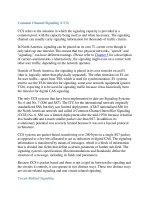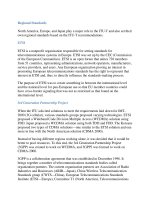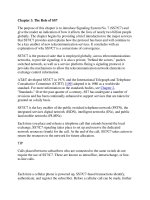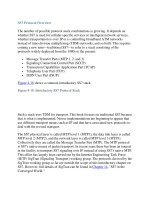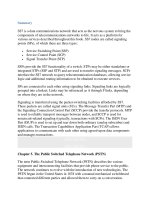Signaling System No.7 Protocol Architecture And Sevices part 67 pps
Bạn đang xem bản rút gọn của tài liệu. Xem và tải ngay bản đầy đủ của tài liệu tại đây (41.56 KB, 6 trang )
Appendix C. SCCP Messages (ANSI/ETSI/ITU-T)
The table in this appendix summarizes Signaling Connection Control Part (SCCP)
messages and the purpose of each. For an introduction to SCCP, refer to Chapter 9
,
"Signaling Connection Control Part (SCCP)."
Table C-1. SCCP Messages
MESSAGE/CODE
FULL MESSAGE
NAME PURPOSE
CR
0 0 0 0 0 0 0 1
Connection
Request
Sent by SCCP to another SCCP peer to
request a setup of a logical signaling
connection between them so that data
transfer can take place in a connection-
orientated fashion.
CC
0 0 0 0 0 0 1 0
Connection
Confirm
Sent in response to a CR message to
indicate that the node has performed
the setup of the requested logical
signaling connection.
CREF
0 0 0 0 0 0 1 1
Connection
Refused
Sent by the destination or an
intermediate SCCP node in response to
a CR message to indicate a refusal to
set up a logical signaling connection.
AK (NE)
0 0 0 0 1 0 0 0
Data
Acknowledgment
May be sent when using protocol class
3 to control the window flow.
DT1
0 0 0 0 0 1 1 0
Data Form 1 Sent by either end of a logical
signaling connection to pass SCCP
user data transparently between two
SCCP nodes. DT1 is only used in
protocol class 2.
DT2 (NE)
0 0 0 0 0 1 1 1
Data Form 2 Sent by either end of a logical
signaling connection to pass SCCP
user data transparently between two
SCCP nodes. DT2 is only used in
protocol class 3.
ED (NE)
0 0 0 0 1 0 1 1
Expedited Data Performs the same function as the DT2
message, but includes the capability to
bypass the flow control mechanism and
is, therefore, only used in protocol
class 3.
EA (NE)
0 0 0 0 1 1 0 0
Expedited Data
Acknowledgment
Used to acknowledge an ED message.
Each ED message must be
acknowledged before another is sent.
XUDT
0 0 0 1 0 0 0 1
Extended Unitdata Used by SCCP to transmit data with
optional parameters, using
connectionless classes 0 and 1.
XUDTS
0 0 0 1 0 0 1 0
Extended Unitdata
Service
Sent back in response to a XUDT
message if the XUDT message cannot
be delivered to its destination. Only
used when the optional field in XUDT
is set to "return on error." Protocol
class indeterminate due to absence of
protocol class parameter.
IT
0 0 01 0 0 0 0
Inactivity Test May be sent periodically by either end
of a logical signaling connection to
make sure the logical signaling
connection is active and to audit the
consistency of connection data at both
ends. Used in connection-orientated
classes 2 and 3.
LUDT
0 0 0 1 0 0 1 1
Long Unitdata Used by SCCP to transmit data with
optional parameters, using
connectionless 0 and 1. If ATM is the
underlying network, it allows sending
of Network Service Data Unit (NSDU)
sizes up to 3952 octets without
segmentation.
LUDTS
0 0 0 1 0 1 0 0
Long Unitdata
Service
Sent back in response to a LUDT
message if the LUDT message cannot
be delivered to its destination. Only
used when the optional field in LUDT
is set to "return on error." Protocol
class indeterminate due to absence of
protocol class parameter.
ERR
0 0 0 0 1 1 1 1
Protocol Data Unit
Error
Sent on detection of any protocol
errors. Used during the data transfer
phase in connection-orientated classes
2 and 3.
RLC
0 0 0 0 0 1 0 1
Release Complete Sent in response to the Released
(RLSD) message to indicate that the
RLSD message was received and that
the necessary procedures have been
performed. Used during connection
release phase in connection-orientated
classes 2 and 3.
RLSD
0 0 0 0 0 1 0 0
Released Sent to indicate that the sending SCCP
wishes to release a logical signaling
connection and that the associated
resources have been brought into the
disconnect pending condition. Also
indicates that the receiving node should
release the logical signaling connection
and its associated resources.
Used during connection release phase
in connection-orientated classes 2 and
3.
RSC (NE)
0 0 0 0 1 1 1 0
Reset Confirm Sent in response to a Reset Request
(RSR) message to indicate that RSR
has been received and that the
necessary procedure has been
performed.
Used during the data transfer phase in
connection-orientated class 3.
RSR (NE) Reset Request Sent to indicate that the sending SCCP
wishes to initiate a reset procedure (re-
0 0 0 0 1 1 0 1 initialization of sequence numbers)
with the receiving SCCP.
Used during the data transfer phase in
protocol class 3.
SBR (M)(A)
1 1 1 1 1 1 0 1
Subsystem Backup
Routing
Optional message sent before rerouting
traffic to the backup subsystem.
Provides more connectivity
information so the end node can
determine the traffic mix received for a
subsystem.
SNR (M)(A)
1 1 1 1 1 1 1 1 0
Subsystem Normal
Routing
Optional message sent prior to
rerouting traffic to the primary
subsystem, to the backup of the
subsystem that is now allowed. Allows
the end node to update the traffic mix
information that the subsystem is
receiving.
SRT (A)
1 1 1 1 1 1 1 1
Subsystem Routing
Status Test
Optional message sent to verify the
routing status of a subsystem marked
as under backup routing.
SSA (M)
0 0 0 0 0 0 0 1
Subsystem
Allowed
Used by SCCP subsystem management
(SCMG) to inform SCMG at
concerned destinations that a formerly
prohibited subsystem (such as
VLR/HLR) is now available, or that a
previously unavailable SCCP is now
available. As a result, the node
receiving the SSA updates its
translation tables.
SSP (M)
0 0 0 0 0 0 1 0
Subsystem
Prohibited
Used by SCCP subsystem management
(SCMG) to inform SCMG at
concerned destinations that a
subsystem (such as VLR/HLR) has
failed. The receiving end of an SSP
message updates its translation tables;
as a result, traffic could be re-routed to
a backup subsystem, if available.
SST (M)
0 0 0 0 0 0 1 1
Subsystem Status
Test
Used by SCCP subsystem management
(SCMG) to verify the status of a
subsystem marked prohibited or the
status of an SCCP marked unavailable.
The receiving node checks the status of
the named subsystem and, if the
subsystem is allowed, sends an SSA
message in response. If the subsystem
is prohibited, no reply is sent.
SOR (M)
0 0 0 0 0 1 0 0
Subsystem Out-of-
Service Request
Used by SCCP subsystem management
(SCMG) to allow subsystems to go
out-of-service without degrading
performance of the network.
SOG (M)
0 0 0 0 0 1 0 1
Subsystem Out-of-
service-grant
Used by SCCP subsystem management
(SCMG) in response to a Subsystem
Out-of-Service Request (SOR)
message to the requesting SCCP if both
the requested SCCP and the backup of
the affected subsystem agree to the
request.
SSC (M)(I)
0 0 0 0 0 0 1 0
SCCP/subsystem-
congested
Sent when an SCCP node experiences
congestion.
UDT
0 0 0 0 1 0 0 1
Unitdata Used by SCCP to transmit data, using
connectionless classes 0 and 1.
UDTS
0 0 0 0 1 0 1 0
Unitdata Service Sent in response to a UDT message if
the UDT message cannot be delivered
to its destination. Only used when the
optional field in UDT is set to "return
on error." Used in connectionless
protocol classes 0 and 1.
KEY: (A)—Messages supported in ANSI SCCP Messages not supported in ETSI
SCCP [].cellular network, does not seem place to define them as reader should
know them only [2].
(I)—Messages supported in ITU-T SCCP only [60
].
(NE)—Messages not supported in ETSI SCCP [10
].
(M)—SCCP subsystem management (SCMG). These are transmitted within the
data parameter a UDT, XUDT or LUDT message.


